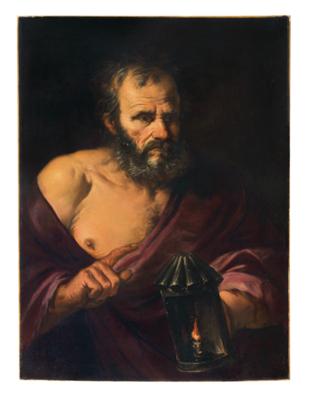Roman School, 17th Century
Diogenes,
oil on canvas, 90 x 67 cm, framed
Provenance:
Private European collection
The present painting represents the Greek philosopher Diogenes of Sinope, half-length, wearing a porphyry-coloured toga, emerging from the dark background as if lit only by the lantern he holds in his left hand. With his extended right index finger, he seems to address an interlocutor to whom he turns, almost as to command attention.
It is with this gesture that Diogenes seemingly warns the viewer not to succumb to the vices of a materialist life. Indeed, the philosopher is known as a founder of the School of Cynics and for his life committed to poverty and philosophic asceticism. The lantern indicates his intent in ‘searching for man’ day and night in the attempt to free him from ephemeral goods that would lead him away from the search for and exercise of virtue (Diogenes Laertius, Life of the philosophers, VI, 41). The figure of Diogenes is painted with a high interest in realism, enhanced by the use of the lantern as the sole source of light, creating a bold play of chiaroscuro that draws into relief every detail of the philosopher’s body, from the wrinkles on his face and the curls of his beard to the folds, of his flesh at the neck and on his hands.
This work can be attributed to an artist close to the so-called ‘tenebrists’ of late seventeenth century Rome, towards the end of the 17th century such as Giacinto Brandi (1623–1691), Giovanni Battista Beinaschi (1636–1688), Daniel Seiter (1649–705), Bernhard Keilhau, called Monsù Bernardo (1624–1687), Girolamo Troppa (1636–1711) and Agostino Scilla (1629–1700). These painters wanted to create compositions of realism, influenced by the achievements the previous generation, notably: Pierfrancesco Mola (1612–1666), Salvator Rosa (1615–1673) and Mattia Preti (1613–1699). These artists developed a style of painting, opposed to the prevailing classicism promoted by the theories of Giovanni Pietro Bellori (see F. Petrucci, I tenebristi del tardo Seicento romano: aggiunte a Scilla, Albertoni e Troppa, in: Arte documento, 28, 2012, pp. 154–159).
Expert: Mark MacDonnell
 Mark MacDonnell
Mark MacDonnell
+43 1 515 60 403
oldmasters@dorotheum.com
25.10.2023 - 18:00
- Dosažená cena: **
-
EUR 26.000,-
- Odhadní cena:
-
EUR 20.000,- do EUR 30.000,-
Roman School, 17th Century
Diogenes,
oil on canvas, 90 x 67 cm, framed
Provenance:
Private European collection
The present painting represents the Greek philosopher Diogenes of Sinope, half-length, wearing a porphyry-coloured toga, emerging from the dark background as if lit only by the lantern he holds in his left hand. With his extended right index finger, he seems to address an interlocutor to whom he turns, almost as to command attention.
It is with this gesture that Diogenes seemingly warns the viewer not to succumb to the vices of a materialist life. Indeed, the philosopher is known as a founder of the School of Cynics and for his life committed to poverty and philosophic asceticism. The lantern indicates his intent in ‘searching for man’ day and night in the attempt to free him from ephemeral goods that would lead him away from the search for and exercise of virtue (Diogenes Laertius, Life of the philosophers, VI, 41). The figure of Diogenes is painted with a high interest in realism, enhanced by the use of the lantern as the sole source of light, creating a bold play of chiaroscuro that draws into relief every detail of the philosopher’s body, from the wrinkles on his face and the curls of his beard to the folds, of his flesh at the neck and on his hands.
This work can be attributed to an artist close to the so-called ‘tenebrists’ of late seventeenth century Rome, towards the end of the 17th century such as Giacinto Brandi (1623–1691), Giovanni Battista Beinaschi (1636–1688), Daniel Seiter (1649–705), Bernhard Keilhau, called Monsù Bernardo (1624–1687), Girolamo Troppa (1636–1711) and Agostino Scilla (1629–1700). These painters wanted to create compositions of realism, influenced by the achievements the previous generation, notably: Pierfrancesco Mola (1612–1666), Salvator Rosa (1615–1673) and Mattia Preti (1613–1699). These artists developed a style of painting, opposed to the prevailing classicism promoted by the theories of Giovanni Pietro Bellori (see F. Petrucci, I tenebristi del tardo Seicento romano: aggiunte a Scilla, Albertoni e Troppa, in: Arte documento, 28, 2012, pp. 154–159).
Expert: Mark MacDonnell
 Mark MacDonnell
Mark MacDonnell
+43 1 515 60 403
oldmasters@dorotheum.com
|
Horká linka kupujících
Po-Pá: 10.00 - 17.00
old.masters@dorotheum.at +43 1 515 60 403 |
| Aukce: | Obrazy starých mistrů |
| Typ aukce: | Sálová aukce s Live bidding |
| Datum: | 25.10.2023 - 18:00 |
| Místo konání aukce: | Wien | Palais Dorotheum |
| Prohlídka: | 14.10. - 25.10.2023 |
** Kupní cena vč. poplatku kupujícího a DPH
Není již možné podávat příkazy ke koupi přes internet. Aukce se právě připravuje resp. byla již uskutečněna.

